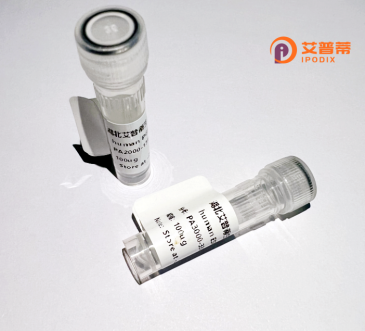
| 纯度 | >90%SDS-PAGE. |
| 种属 | Human |
| 靶点 | CD229 |
| Uniprot No | Q9HBG7 |
| 内毒素 | < 0.01EU/μg |
| 表达宿主 | E.coli |
| 表达区间 | 48-454aa |
| 氨基酸序列 | KDSAPTVVSGILGGSVTLPLNISVDTEIENVIWIGPKNALAFA RPKENVTIMVKSYLGRLDIT KWSYSLCISN LTLNDAGSYK AQINQRNFEVTTEEEFTLFVYEQLQEPQVTMKSVKVSENFSCNITLMCSV KGAEKSVLYSWTPREPHASESNGGSILTVSRTPCDPDLPYICTAQNPVSQ RSSLPVHVGQFCTDPGASRGGTTGETVVGVLGEPVTLPLALPACRDTEKV VWLFNTSIISKEREEAATADPLIKSRDPYKNRVWVSSQDCSLKISQLKIE DAGPYHAYVCSEASSVTSMTHVTLLIYRRLRKPKITWSLRHSEDGICRIS LTCSVEDGGN TVMYTWTPLQKEAVVSQGES HLNVSWRSSE NHPNLTCTAS NPVSRSSHQFLSENICSGPERNTK |
| 预测分子量 | 39 kDa |
| 蛋白标签 | His tag N-Terminus |
| 缓冲液 | PBS, pH7.4, containing 0.01% SKL, 1mM DTT, 5% Trehalose and Proclin300. |
| 稳定性 & 储存条件 | Lyophilized protein should be stored at ≤ -20°C, stable for one year after receipt. Reconstituted protein solution can be stored at 2-8°C for 2-7 days. Aliquots of reconstituted samples are stable at ≤ -20°C for 3 months. |
| 复溶 | Always centrifuge tubes before opening.Do not mix by vortex or pipetting. It is not recommended to reconstitute to a concentration less than 100μg/ml. Dissolve the lyophilized protein in distilled water. Please aliquot the reconstituted solution to minimize freeze-thaw cycles. |
以下是3篇关于CD229(Ly9/SLAMF3)重组蛋白的相关文献概览:
---
1. **文献名称**: *"Structural and functional analysis of the Ly9 (CD229) cell surface receptor"*
**作者**: Romero et al., 2005
**摘要**: 研究通过重组CD229蛋白解析其胞外结构域的二聚化机制,发现其免疫球蛋白样结构域在T细胞和B细胞信号转导中的关键作用,揭示了CD229与配体结合的特异性。
---
2. **文献名称**: *"CD229/Ly9 modulates innate immune responses by regulating TLR signaling pathways"*
**作者**: González et al., 2012
**摘要**: 利用重组CD229蛋白进行功能实验,证明其通过抑制TLR4和TLR9介导的炎症因子释放,调节巨噬细胞对病原体的免疫应答,提示CD229在自身免疫病中的潜在调控机制。
---
3. **文献名称**: *"Recombinant CD229 protein enhances T cell activation and antitumor immunity"*
**作者**: Chen et al., 2018
**摘要**: 研究体外表达的重组CD229蛋白对T细胞活化的影响,发现其通过增强CD8+ T细胞增殖及细胞毒性,促进肿瘤模型中的抗肿瘤免疫应答,为癌症免疫治疗提供新靶点。
---
如需更具体的文献或补充年份/期刊信息,可进一步说明!
CD229. also known as Ly9 or SLAMF3. is a cell surface glycoprotein belonging to the signaling lymphocytic activation molecule (SLAM) family of immune receptors. It is primarily expressed on T and B lymphocytes, playing a regulatory role in adaptive immunity. Structurally, CD229 contains multiple immunoglobulin (Ig)-like domains in its extracellular region, including two variable (V)-type and two constant (C2)-type Ig domains, followed by a transmembrane domain and a cytoplasmic tail with immunoreceptor tyrosine-based switch motifs (ITSMs). These ITSMs enable interactions with intracellular adaptors like SAP family proteins, facilitating signal transduction.
Recombinant CD229 protein is engineered in vitro using expression systems (e.g., mammalian cells, bacteria) to produce soluble forms of its extracellular domain, often fused with tags (e.g., Fc, His-tag) for purification and detection. This tool enables researchers to study CD229’s ligand interactions, receptor oligomerization, and signaling mechanisms. Functionally, CD229 modulates lymphocyte activation, differentiation, and tolerance. It engages in homophilic interactions (CD229-CD229 binding) between immune cells, influencing immune synapse formation and cytokine production. Dysregulation of CD229 has been linked to autoimmune diseases (e.g., lupus) and hematologic malignancies, highlighting its potential as a therapeutic target.
Current research leverages recombinant CD229 protein to develop blocking antibodies, map binding epitopes, and explore its role in immune checkpoint regulation. Its applications extend to immunotherapy development, particularly in modulating overactive immune responses in autoimmunity or enhancing antitumor immunity. Studies also investigate its diagnostic value as a biomarker in lymphocyte-related disorders.
×